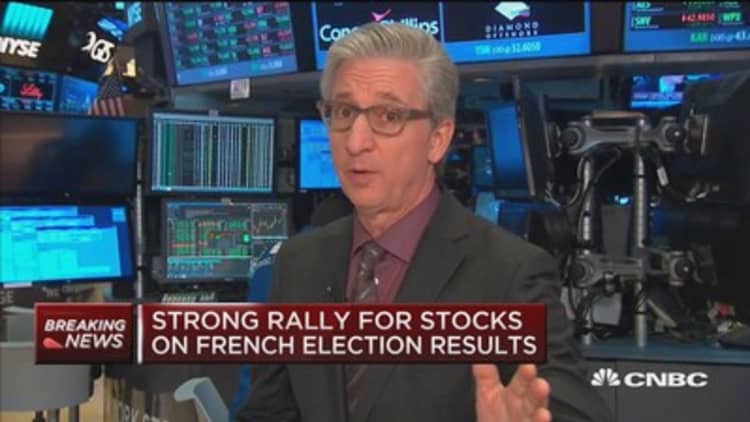
Are market risks declining? You would think so, watching the market reaction to the French election. The French CAC at a 9-year high. The (VIX), after popping early last week to the highest level since the election, is collapsing today.
More importantly the U.S. is seeing a broad rally, with three stocks advancing for every one declining, and more than 200 new highs on the NYSE.
There are four major market risks we have been discussing for months. Here they are, and here's how I assess the risk factor for each:
- Geopolitical. Risk to markets: lower but still present. The markets are telling us that there was some risk premium associated with the French elections, and the premium existed not just in Europe but also in Japan and the United States. The risks are lower, but with North Korea looming, geopolitical risk is still very much present. President Trump, in a meeting with the U.N. Security Council today, said "North Korea is a big world problem."
- Weaker economic data. Risk to markets: high. We are expecting anemic first quarter GDP of 1.1 percent. Other measures of "hard" economic news, including Retail Sales, have generally been weaker than expected. Bulls are insisting that first quarter economic data has been weak for several years and that second quarter data will show notable improvement. They have a major ally in global growth ex-U.S., which is clearly in a modest uptrend. The French outcome can only be helpful to the European economy, and likely to European bond yields.
- The high valuation of the stock market and the risk from disappointing earnings. Risk to markets: was high but is now moderate. With stocks trading at more than 18 times 2017 earnings, traders were nervous going into the first quarter earnings season. Expectation have been high for the first quarter (11 percent growth in the S&P 500 would be the best quarter since Q3 of 2011) but there's been anxiety about guidance for the full year, particularly in the absence of any hard news on tax cuts. So far, the news has been positive. Banks noted anemic loan growth but were generally upbeat about the U.S. economy and in the belief that interest rates would indeed be higher in the second half of the year. And a half-dozen big Industrial names not only beat earnings expectations but they also raised full-year guidance. The biggest problem right now is that stocks are so expensive that buying enthusiasm is very muted.
- Fiscal reforms pushed out. Risk to markets: moderate. President Trump's tax comment last week that a "massive" tax bill was coming was clearly an exaggeration. We now know there will only be a statement of principles out by Wednesday. We already know the principles, traders want specifics. The market continues to believe that the combination of lower taxes, infrastructure spending, and fewer regulations will be a positive for the markets. The problem is that the outcome is so varied that there is a strong chance corporate tax cuts will only be very moderate.
Where does this leave us? The S&P 500, at roughly 2,370, is about 30 points below its March 1st record high. That is just a little above the middle of the trading range we have been in since the middle of March, that is, between about 2,325 and 2,400.
The likely outcome will be a short-term trading range but the long-term risk is clearly to the upside. Why?
Absent a geopolitical crisis, the other risks have a good chance of resolving to the upside. Earnings growth expectations are holding up, so far. U.S. economic data is likely to improve, which means there are no signs of an economic recession, the surest killer of rallies, and there isn't even a big indication of a correction on the horizon. Lowry's, the oldest technical analysis service, noted this morning that classic signs of market deterioration, like selective leadership and days of heavy selling, are still nowhere to be seen: "Those signs of lengthy deterioration are simply not in evidence at the present time."
No wonder the markets are rallying.


